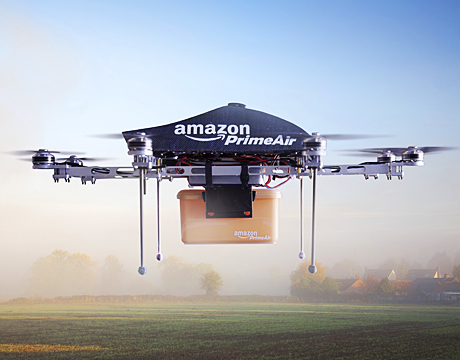Developing Delivery Drones
Developing Delivery Drones


Drone image: Amazon.com
The swarm is coming. Thousands of insectoid, robotic, autonomous drones will soon fill our skies. But instead of working en masse in some search-and-rescue operation, chasing down some otherwise inaccessible enemy, or spying on previously remote hideouts, they’ll be heightening the world’s got-to-have-it-now consumerism, hauling individual packages through the air from warehouse to doorstep.
In early December, a 60 Minutes feature on Amazon unveiled the company’s plans to deliver by drone. The clip showed yellow boxes sliding down a conveyor belt into the ready clutches of an octocopter, which then took off with a whine and a buzz, flew over fields to a comely neighborhood, descended to a driveway, relinquished the package, and took off again. CEO Jeff Bezos suggested that real customers could be receiving goods with such a service in five years or so.
While the news stoked anti-drone fires in various states (including Deer Trail, CO, the citizens of which are soon to vote on whether or not to issue drone hunting licenses), those in the flying robotics community were simply stoked.
“It’s similar to the venture that Google is making toward autonomous cars—a big company throwing a lot of resources at solving a problem that’s been stewing around in the academic research community for a decade or two,” says Matthew Spenko, an associate professor of mechanical engineering at the Illinois Institute of Technology who’s designed his own crash-proof quadrotor.With all that stewing, those researchers have a pretty good bead on what problems lie ahead for Amazon. “We can control these quadrotors in well controlled environments, we can do the visual processing,” says Spenko. “It’s there, we can do it. But it’s going to take an engineering effort.”
Much of that effort is likely to come from the robotics company Kiva Systems, North Reading, MA, which Amazon bought for $775 million last year. One of its co-founders, Raffaello D’Andrea, is a professor who has pioneered what might be called aerobatic robotics. Days after the 60 Minutes piece aired, Kiva released a video showing how their quadcopters can remain airborne after one of its propellers becomes inoperable. D’Andrea says that safety is of the “utmost importance.”
Smart Software
The push for safety, and feasibility, and actuality, will have little to do with hardware development. With off-the-shelf systems (available through Amazon, of course), amateur enthusiasts can already fly, spy, and land similar quadrotors. “That’s the easy part,” says Spenko. “The hard part is going to be the autonomy.” A robot trying to get to a destination and back has to do all the things usually left to humans. That means reading a map, adjusting for wind and weather, making detours where necessary, dodging moving objects.
“The software needs to be smart enough to say, ‘Hey this is a tree, this is a wire’—these are hard problems,” says Ashutosh Saxena, a professor of computer science at Cornell who’s managed to make an autonomous quadrotor that can navigate stairs indoors. “If you are trying to fly, and it’s fall and leaves are on the ground, how would you figure out that it’s not trees on the ground, that it’s on the ground and you can land on it?” asks Saxena.
Urban Setting
In a world where robots routinely catch balls hurled at them, the problem may seem entirely surmountable. But as you move from clean controlled labs to busy ever-changing city streets, things get thornier. “People on the street are not yellow objects,” says Saxena. “They look very different from each other, they don’t follow Newtonian physics, they stoop and turn and jump randomly—that’s why people bump into each other.How you see the environment and then take action, avoiding people, and try to fly in a busy street or crowded city is more of a perception problem.” And it’s not likely to be solved with more power, faster processors, or better sensors. It’s just a matter of making the robots smarter. “They can start deliveries in a few places, but as soon as they extend to larger scenarios it’s not possible to make such programs. The software isn’t capable yet.”
A shift from the idyllic, uncluttered suburbia featured in their video clip to the urban centers that contain the vast number of customers Amazon hopes to reach by drone may require solutions beyond the technology. “I’m thinking about the street that I live on,” says Spenko of his home in Chicago. “It very different from the street in the Amazon video. We’re very tied together, with small landing areas, all sorts of urban canyons where GPS would presumably die out. A four story duplex—I don’t think you could fly close to that.” To get to such a home with current technological capabilities will mean altering laws and expectations. Perhaps the drones will be allowed to land on rooftops, or, as one of Spenko’s students suggested, they could hitch rides on local transportation and take to the air for a final short leg of their journey.
However tricky the hoops and hurdles the company will have to fly through and over, they’re not likely to stymie the project. “Building up the whole system is a significant challenge,” says Saxena. “But these giants like Amazon are good at doing that.”
Michael Abrams is an independent writer.
The software needs to be smart enough to say 'Hey this is a tree, this is a wire'’ - these are hard problems.Prof. Ashutosh Saxena, Cornell University




